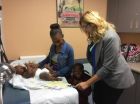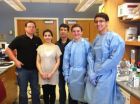(Press-News.org) SEATTLE—People living in poverty are less likely to be screened regularly for colorectal cancer—and more likely to develop the disease and die from it. How to end these disparities—and raise screening rates, lower disease rates, and prevent deaths? A promising way is to mail fecal immunochemical tests (a newer kind of stool test) to populations, Beverly B. Green, MD, MPH, and Gloria D. Coronado, PhD, wrote in the June 17 JAMA Internal Medicine.
Dr. Green is a Group Health physician and an associate investigator at Group Health Research Institute. Dr. Coronado is a senior investigator and the Mitch Greenlick endowed scientist for health disparities at Kaiser Permanente Center for Health Research, in Portland. The journal invited them to write a commentary about a study that David W. Baker, MD, MPH, of Northwestern University led and published in the same issue of the journal.
Drs. Green and Coronado applauded Baker's study for achieving repeat screening rates of more than 82 percent in a largely low-income community. But they were disappointed that only 60 percent of individuals with a positive screening stool test completed follow-up diagnostic colonoscopy. "Lack of a follow-up colonoscopy defeats the purpose of a stool-test screening program," said Dr. Green, who is also an assistant clinical professor at the University of Washington School of Medicine.
Previous studies have shown that when low-income people get colorectal cancer screening, they tend to prefer the option of doing a stool test in the privacy of their own home. But when the test is "positive" (detecting microscopic blood in the stool), people need to get a second test: a follow-up diagnostic colonoscopy. After a positive stool test, nearly a third of people have advanced pre-cancers that can be removed during the follow-up colonoscopy—and 4 percent have colorectal cancer.
"For many people, the barriers to receiving the needed follow-up diagnostic colonoscopy include cost," Dr. Green said. For instance, the Affordable Care Act (ACA) mandates full coverage of screening tests that the U.S. Preventive Services Task Force (USPSTF) recommends—with no out-of-pocket expenses. But it covers only the first test that a person chooses—a stool test, colonoscopy, or sigmoidoscopy—not any follow-up diagnostic testing. That's why Drs. Green and Coronado previously urged that the ACA be amended to cover co-pays for follow-up colonoscopies after a positive stool test or flexible sigmoidoscopy. Otherwise, people who choose those as their first tests could face high, unexpected costs from follow-up testing—and existing disparities in screening could worsen.
"On the other hand, most states' Medicaid insurance pays for both stool testing and follow-up colonoscopy, with no out-of-pocket patient costs," Dr. Coronado said. "So disparities in deaths from colorectal cancer could decrease rapidly in those states that have opted into Medicaid expansion."
Dr. Green previously showed in a randomized trial that colorectal cancer screening doubled when Group Health's electronic health record was used in a new way to identify people who needed screening and give them stepped increases in support. And Drs. Green and Coronado showed it was feasible to use a population-based program for mailing stool tests to people in safety-net clinics.
INFORMATION:
Group Health Research Institute
Group Health Research Institute does practical research that helps people like you and your family stay healthy. The Institute is the research arm of Seattle-based Group Health Cooperative, a consumer-governed, nonprofit health care system. Founded in 1947, Group Health Cooperative coordinates health care and coverage. Group Health Research Institute changed its name from Group Health Center for Health Studies in 2009. Now celebrating its 30th anniversary year, the Institute has conducted nonproprietary public-interest research on preventing, diagnosing, and treating major health problems since 1983. Government and private research grants provide its main funding.
Kaiser Permanente Center for Health Research
The Kaiser Permanente Center for Health Research, founded in 1964, is a nonprofit research institution dedicated to advancing knowledge to improve health. It has research sites in Portland, Ore., Honolulu, and Atlanta.
How to prevent disparities in colon cancer screening
Group Health, Kaiser Permanente researchers in JAMA Internal Medicine
2014-06-16
ELSE PRESS RELEASES FROM THIS DATE:
When patients wish for a miracle, tool helps medical staff say 'amen'
2014-06-16
Cancer clinicians and a chaplain at the Johns Hopkins Kimmel Cancer Center have developed a new tool to help doctors, nurses and other health care providers talk to dying patients and families who are, literally, praying for a miracle.
The AMEN (Affirm, Meet, Educate, No matter what) protocol, a script that can be used by medical staff, offers a way to negotiate these challenging conversations to affirm or acknowledge a patient's hope, share the patient's wish with others, continue to educate the patient and family about medical issues, and assure them that their health ...
Redesigning the well-child checkup
2014-06-16
Well-child visits are the foundation of pediatric primary care in the U.S. Accounting for more than one-third of all outpatient visits for infants and toddlers, the appointments are intended to give doctors the opportunity to identify health, social, developmental and behavioral issues that could have a long-term impact on children's lives.
However, several studies have shown that the current system of well-child care leaves room for improvement. One major concern is that well-child care guidelines issued by the American Academy of Pediatrics call for physicians to provide ...
Many bodies prompt stem cells to change
2014-06-16
HOUSTON – (June 16, 2014) – How does a stem cell decide what path to take? In a way, it's up to the wisdom of the crowd.
The DNA in a pluripotent stem cell is bombarded with waves of proteins whose ebb and flow nudge the cell toward becoming blood, bone, skin or organs. A new theory by scientists at Rice University shows the cell's journey is neither a simple step-by-step process nor all random.
Theoretical biologist Peter Wolynes and postdoctoral fellow Bin Zhang set out to create a mathematical tool to analyze large, realistic gene networks. As a bonus, their open-access ...
Researchers create better methods to detect E. coli
2014-06-16
MANHATTAN, KANSAS — Kansas State University diagnosticians are helping the cattle industry save millions of dollars each year by developing earlier and accurate detection of E. coli.
Lance Noll, master's student in veterinary biomedical science, Greensburg; T.G. Nagaraja, university distinguished professor of diagnostic medicine and pathobiology; and Jianfa Bai, assistant professor in the Kansas State Veterinary Diagnostic Laboratory, are leading a project to improve techniques for detecting pathogenic Shiga toxin-producing E. coli O157:H7. A U.S. Department of Agriculture ...
Getting rid of old mitochondria
2014-06-16
It's broadly assumed that cells degrade and recycle their own old or damaged organelles, but researchers at University of California, San Diego School of Medicine, The Johns Hopkins University School of Medicine and Kennedy Krieger Institute have discovered that some neurons transfer unwanted mitochondria – the tiny power plants inside cells – to supporting glial cells called astrocytes for disposal.
The findings, published in the June 17 online Early Edition of PNAS, suggest some basic biology may need revising, but they also have potential implications for improving ...
Discovery of Earth's northernmost perennial spring
2014-06-16
Boulder, Colo., USA – A Canadian team lead by Stephen Grasby reports the discovery of the highest latitude perennial spring known in the world. This high-volume spring demonstrates that deep groundwater circulation through the cryosphere occurs, and can form gullies in a region of extreme low temperatures and with morphology remarkably similar to those on Mars. The 2009 discovery raises many new questions because it remains uncertain how such a high-volume spring can originate in a polar desert environment.
Grasby and colleagues encountered the northernmost perennial ...
Pathological gambling runs in families
2014-06-16
A study by University of Iowa researchers confirms that pathological gambling runs in families and shows that first-degree relatives of pathological gamblers are eight times more likely to develop this problem in their lifetime than relatives of people without pathological gambling.
"Our work clearly shows that pathological gambling runs in families at a rate higher than for many other behavioral and psychiatric disorders," says Donald W. Black, MD, professor of psychiatry in the UI Carver College of Medicine. "I think clinicians and health care providers should be alerted ...
Low dose of targeted drug might improve cancer-killing virus therapy
2014-06-16
COLUMBUS, Ohio – Giving low doses of a particular targeted agent with a cancer-killing virus might improve the effectiveness of the virus as a treatment for cancer, according to a study led by researchers at The Ohio State University Comprehensive Cancer Center – Arthur G. James Cancer Hospital and Richard J. Solove Research Institute (OSUCCC – James).
Viruses that are designed to kill cancer cells – oncolytic viruses – have shown promise in clinical trials for the treatment of brain cancer and other solid tumors. This cell and animal study suggests that combining low ...
How our brains store recent memories, cell by single cell
2014-06-16
Confirming what neurocomputational theorists have long suspected, researchers at the Dignity Health Barrow Neurological Institute in Phoenix, Ariz. and University of California, San Diego School of Medicine report that the human brain locks down episodic memories in the hippocampus, committing each recollection to a distinct, distributed fraction of individual cells.
The findings, published in the June 16 Early Edition of PNAS, further illuminate the neural basis of human memory and may, ultimately, shed light on new treatments for diseases and conditions that adversely ...
Omega (ω)-3 inhibits blood vessel growth in a model of age-related macular degeneration in vivo
2014-06-16
Boston (June 16, 2014) – Age-related macular degeneration (AMD), which is characterized by choroidal neovascularization (CNV), or blood vessel growth, is the primary cause of blindness in elderly individuals of industrialized countries. The prevalence of the disease is projected to increase 50% by the year 2020. There is an urgent need for new pharmacological interventions for the treatment and prevention of AMD.
Researchers from Massachusetts Eye and Ear/Schepens Eye Research Institute, Harvard Medical School and other institutions have demonstrated for the first time ...
LAST 30 PRESS RELEASES:
Sports injuries sustained during your period might be more severe
World's first successful 2 Tbit/s free-space optical communication using small optical terminals mountable on satellites and HAPS
Can intimate relationships affect your heart? New study says ‘yes’
Scalable and healable gradient textiles for multi‑scenario radiative cooling via bicomponent blow spinning
Research shows informed traders never let a good climate crisis go to waste
Intelligent XGBoost framework enhances asphalt pavement skid resistance assessment
Dual-function biomaterials for postoperative osteosarcoma: Tumor suppression and bone regeneration
New framework reveals where transport emissions concentrate in Singapore
NTP-enhanced lattice oxygen activation in Ce-Co catalysts for low-temperature soot combustion
Synergistic interface engineering in Cu-Zn-Ce catalysts for efficient CO2 hydrogenation to methanol
COVID-19 leaves a lasting mark on the human brain
Scientists use ultrasound to soften and treat cancer tumors without damaging healthy tissue
Community swimming program for Black youth boosts skills, sense of belonging, study finds
Specific depressive symptoms in midlife linked to increased dementia risk
An ‘illuminating’ design sheds light on cholesterol
Who is more likely to get long COVID?
Study showcases resilience and rapid growth of “living rocks”
Naval Research Lab diver earns Office of Naval Research 2025 Sailor of the Year
New Mayo-led study establishes practical definition for rapidly progressive dementia
Fossil fuel industry’s “climate false solutions” reinforce its power and aggravate environmental injustice
Researchers reveal bias in a widely used measure of algorithm performance
Alcohol causes cancer. A study from IOCB Prague confirms damage to DNA and shows how cells defend against it
Hidden viruses in wastewater treatment may shape public health risks, study finds
Unlock the power of nature: how biomass can transform climate mitigation
Biochar reshapes hidden soil microbes that capture carbon dioxide in farmland
Reducing saturated fat intake shows mortality benefit, but only in high-risk individuals
Manta rays create mobile ecosystems, study finds
Study: Mixed results in using lipoic acid to treat progressive multiple sclerosis
Norbert Holtkamp appointed director of Fermi National Accelerator Laboratory
New agentic AI platform accelerates advanced optics design
[Press-News.org] How to prevent disparities in colon cancer screeningGroup Health, Kaiser Permanente researchers in JAMA Internal Medicine







